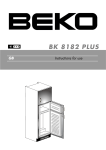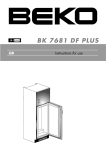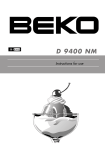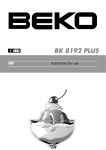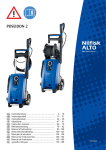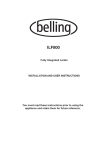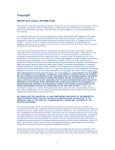Download Beko BK 7671 LD PLUS Refrigerator User Manual
Transcript
BK 7671 LD PLUS GB Instructions for use GB Index 1-8 Safety first/1 Electrical requirements/2 Transportation instructions/2 Installation instructions/2 Suggested arrangement of food in the larder fridge/3 Temperature control and adjustment/4 Before operating/4 Getting to know your appliance/5 Defrosting/5 Replacing the interior light bulb/6 Cleaning and care/6-7 Repositioning the door/7 Do’s and don’ts/7-8 Trouble - shooting/8 7 6 8 1 2 8 1 10 3 4 9 5 1 10 2 3 4 1 4 3 2 5 6 10 7 9 8 5 Instructions for use GB Quality Congratulations on your choice of a Appliance, designed to give you many years of service. Safety first! Do not connect your appliance to the electricity supply until all packing and transit protectors have been removed. • Leave to stand for at least 4 hours before switching on, to allow compressor oil to settle, if transported horizontally. • If you are discarding an old appliance with a lock or latch fitted to the door, ensure that it is left in a safe condition to prevent the entrapment of children. • This appliance must only be used for its intended purpose. • Do not dispose of the appliance on a fire. Your appliance contains non CFC substances in the insulation which are flammable. We suggest you contact your local authority for information on disposal and available facilities. • We do not recommend use of this appliance in an unheated, cold room. (e.g. garage, conservatory, annex, shed, out-house etc.) To obtain the best possible performance and trouble free operation from your appliance it is very important to read these instructions carefully. Failure to observe these instructions may invalidate your right to free service during the guarantee period. Please keep these instructions in a safe place for easy reference. 1 Instructions for use GB Electrical requirements Important! • Care must be taken while cleaning/carrying the appliance not to touch the bottom of the condenser metal wires at the back of the appliance, as this could cause injury to fingers and hands. • Do not attempt to sit or stand on top of your appliance as it is not designed for such use. You could injure yourself or damage the appliance. • Make sure that the mains cable is not caught under the appliance during and after moving, as this could damage the cable. • Do not allow children to play with the appliance or tamper with the controls. Before inserting the plug into the wall socket make sure that the voltage and the frequency shown in the rating plate inside the appliance corresponds to your electricity supply. We recommend that this appliance be connected to the mains supply via a suitably switched and fused socket in a readily accessible position. Warning! This appliance must be earthed. Repairs to electrical equipment should only be performed by a qualified technician. Incorrect repairs carried out by an unqualified person are carry risks that may have critical consequences for the user of the appliance. Installation instructions 1. Do not keep your appliance in a room where the temperature is likely to fall below 10 degrees C (50 degrees F) at night and/or especially in winter, as it is designed to operate in ambient temperatures between +10 and +32 degrees C (50 and 90 degrees F). At lower temperatures the appliance may not operate, resulting in a reduction in the storage life of the food. Transportation instructions 1. The appliance should be transported only in a upright position. The packing as supplied must be intact during transportation. 2. If during the course of transport the appliance, has been positioned horizontally, it must not be operated for at least 4 hours, to allow the system tosettle. 3. Failure to comply with the above instructions could result in damage to the appliance, for which the manufacturer will not be held liable. 4. The appliance must be protected against rain, moisture and other atmospheric influences. 2. Do not place the appliance near cookers or radiators or in direct sunlight, as this will cause extra strain on the appliance's functions. If installed next to a source of heat or freezer, maintain the following minimum side clearances: From Cookers 30 mm From Radiators 300 mm From Freezers 25 mm 3. Make sure that sufficient room is provided around the appliance to ensure free air circulation. 2 Instructions for use GB 7. For maximum efficiency, the removable shelves should not be covered with paper or other materials to allow free circulation of cool air. 8. The shelves are fitted with rear stops and tilting for storing bottles. Lift shelf clear of grooves when adjusting. 9. To tilt a shelf, place the back of the shelf one level below the front of the shelf. To remove a tilted shelf, first release the back from the grooves and then pull. 10. Do not keep vegetable oil on door shelves. Keep food packed, wrapped or covered. Allow hot food and beverages to cool before refrigerating. Do not store explosive substances in the refrigerator. High proof alcohol must be stored upright in sealed containers. Leftover canned food should not be stored in the can. 11. Some fruit and vegetables suffer damage if kept at temperatures near 0 degrees centigrade. Therefore wrap pineapples, melon, cucumbers, tomatoes and similar produce in polythene bags. 4. The appliance should be positioned on a smooth surface. 5. Refer to "Cleaning and Care" section to prepare your appliance for use. Suggested arrangement of food in the larder fridge Guidelines for obtaining optimum storage and hygiene: 1. This appliance for the short-term storage of fresh food and drinks. 2. Dairy products should be stored in the special compartment provided in the door liner. 3. Cooked dishes should be stored in airtight containers and are bes kept on either of the removable shelves. 4. Fresh wrapped produce can be kept on the shelf. Fresh fruit and vegetables should be cleaned and stored in the crisper bins. 5. Bottles can be kept in the door section. 6. To store raw meat, wrap in polythene bags and place on the lowest shelf. Do not allow to come into contact with cooked food, to avoid contamination. Fo safety, only store raw meat for two to three days. 3 Instructions for use GB Temperature control and adjustment Before operating Final Check Before you start using the appliance check that: Operating temperatures are controlled by the thermostat knob (Fig. 2) and may be set between 1 and 5, the coldest position. When the appliance is switched on for the first time, the thermostat should be adjusted so that, after 24 hours, the average fridge temperature is no higher than +5°C (+41°F ). We recommend setting the thermostat half-way between the 1 and 5 setting and monitoring to obtain the desired temperature i. e. towards 5 you will obtain a lower temperature and vice versa. Some sections of the fridge may be cooler or warmer ( such as the salad crisper and the top part of the cabinet ) which is quite normal. In ambient temperatures above 25°C (77°F), especially in summer, turn the thermostat knob towards 5. In ambient temperatures below 25°C (77°F) turn the thermostat knob to a half way position. Frequent door opening causes internal temperatures to rise, so it is advisable to close as soon as possible after use. 1. The feet have been adjusted for perfect levelling. 2. The interior is dry and air can circulate freely at the rear. 3. The interior is clean as recommended under "Cleaning and care.” 4. The plug has been inserted into the wall socket and the electricity is switched on. When the door is open the interior light will come on. And note that: 5. You will hear a noise as the compressor starts up. The liquid and gases sealed within the refrigeration system may also make some (noise), whether the compressor is running or not. This is quite normal. 6. We recommend setting the thermostat knob midway and monitor the temperature to ensure the appliance maintains desired storage temperatures (See section Temperature Control and Adjustment). 7. Do not load the appliance immediately it is switched on. Wait until the correct storage temperature has been reached. We recommend checking the temperature with an accurate thermometer (see; Temperature Control and Adjustment). 4 Instructions for use GB Defrosting Getting to know your appliance The larder refrigerator defrosts automatically. The defrosting water runs to the drain tube via a collection channel and is evaporated in a special container at the back of the appliance. During defrosting, water droplets may form at the back of the larder refrigerator where a concealed evaporator is located. Some droplets may remain on the liner and refreeze when defrosting is completed. Do not use pointed or sharp-edged objects such as knives or forks to remove the droplets which have refrozen. If, at any time, the defrost water does not drain from the collection channel, check that no food particles have blocked the drain tube. The drain tube can be cleared by pushing the special plastic plunger provided down the drain tube (Fig. 3). (Fig. 1) 1. 2. 3. 4. 5. 6. 7. 8. 9. 10. Movable shelves Thermostat knob Crisper cover Crisper Air grill Dairy compartment Egg compartment Adjustable door shelves Bottle gripper Bottle shelf 5 Instructions for use GB Cleaning and care Replacing the interior light bulb 1. We recommend that you switch off the appliance at the socket outlet and pull out the mains plug before cleaning. 2. Never use any sharp instruments or abrasive substances, soap, household cleaner, detergent or wax polish for cleaning. 3. Use luke warm water to clean the cabinet of the appliance and wipe it dry. 4. Use a damp cloth wrung out in a solution of one teaspoon of bicarbonate of soda to one pint of water to clean the interior and wipe it dry. 5. Make sure that no water enters the temperature control box. 6. If the appliance is not going to be used for a long period of time, switch it off, remove all food, clean it and leave the door ajar. 7. We recommend that you polish the metal parts of the product (i.e. door exterior, cabinet sides) with a silicone wax (car polish) to protect the high quality paint finish. 8. Any dust that gathers on the condenser, which is located at the back of the appliance, should be removed once a year with a vacuum cleaner. 9. Check door seals regularly to ensure they are clean and free from food particles. 10. Never: • Clean the appliance with unsuitable material; eg petroleum based products. • Subject it to high temperatures in any way, • Scour, rub etc., with abrasive material. 11. Removal of dairy cover and door tray : • To remove the dairy cover, first lift the cover Should the light fail, switch off at the socket outlet and pull out the mains plug. Then ensure the bulb is screwed securely in the bulb holder. Replace the plug and switch on. If the light still fails, obtain a replacement E14 screw-cap type 15 Watt (Max) bulb from your local electrical store and then fit it (Fig. 4).Carefully dispose of the burnt-out light bulb immediately. 6 Instructions for use GB up by about an inch and pull it off from the side where there is an opening on the cover. • To remove a door tray, remove all the contents and then simply push the door tray upwards from the base. 12. Make sure that the special plastic container at the back of the appliance which collects defrost water is clean at all times. If you want to remove the tray to clean it, follow the instructions below: • Switch off at the socket outlet and pull out the mains plug • Gently uncrimp the stud on the compressor, using a pair of pliers, so that the tray can be removed • Lift it up. • Clean and wipe it dry • Reassemble, reversing the sequence and operations Do’s and don’ts Do- Clean your larder refrigerator regularly. Do- Keep raw meat and poultry below cooked food and dairy products. Do- Keep food for as short a time as possible and adhere to 'Best Before' and "Use By" dates. Do- Take off any unusable leaves on vegetables and wipe off any soil. Do- Leave lettuce, cabbage, parsley and cauliflower on the stem. Do- Wrap cheese firstly in greaseproof paper and then in a polythene bag, excluding as much air as possible. For best results, take out of the refrigerator compartment an hour before eating. Do- Wrap raw meat and poultry loosely in polythene or aluminium foil. This prevents drying. Do- Wrap fish and offal in polythene bags. Do- Wrap food with a strong odour or which may dry out, in polythene bags or aluminium foil or place in airtight container. Do- Wrap bread well to keep it fresh. Do- Chill white wines, beer, lager and mineral water before serving. Don’t- Store bananas in your fridge. Don’t- Store melon in your fridge. It can be chilled for short periods as long as it is wrapped to prevent it flavouring other food. Repositioning the door Proceed in numerical order (Fig. 5). 7 Instructions for use GB Trouble - shooting Don't- Leave the door open for long periods as this will make the larder refrigerator more costly to run. Don't- Cover the shelves with any protective materials which may obstruct air circulation. Don't- Store poisonous or any dangerous substances in the larder refrigerator. Your larder refrigerator has been designed for the storage of edible foodstuffs only. Don't- Consume food which has been refrigerated for an excessive length of time. Don't- Store cooked and fresh food together in the same container. They should be packaged and stored separately. Don't- Let defrosting food or food juices drip onto food in your larder refrigerator. If the appliance does not operate when switched on, check; • That the plug is inserted properly in the socket and that the power supply is on. (To check the power supply to the socket, plug in another appliance) • Whether the fuse has blown/circuit breaker has tripped/main distribution switch has been turned off. • That the temperature control has been set correctly. • That the new plug is wired correctly, if you have changed the fitted, moulded plug. If the appliance is still not operating at all after above checks, contact the dealer from whom you purchased the unit. Please ensure that above checks have been done, as a charge will be made if no fault is found. 8 540 548 550 1370 min. 1370 1440 min. 50 mm 1466 560 1440 +4 -0 min. min. 50 mm 35 min. 200 cm2 100 100 60 60 80 2 200 cm min.50 mm X X min.50 mm min.50 mm min.50 mm min.50 mm 200 cm X +4 876 -+40 1466 - 0 81 2 1 5 6 4 1 2 90o 3 82 +_ 1 18 mm 9 8 90 10 11 7 40 -1 mm 83 o 2 mm 2 mm 2 mm 84


















